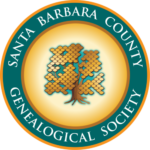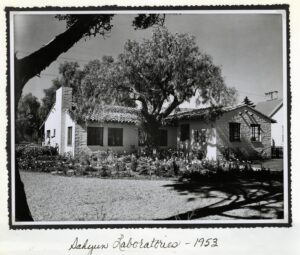Written by Melville R.V. Sahyun, Ph.D.
The Society’s current building was built in 1949 as Sahyun Laboratories, established by my father, Melville Sahyun, Ph.D., a biochemist, as a facility for drug discovery. It was designed by well-known Santa Barbara architect Robert Ingle Hoyt, and won a Santa Barbara Beautiful award. It was sited on property that had been a nursery for decades; the only surviving building on the site was an old barn… now the garage and maintenance building for the Library.
Dr. Sahyun’s focus was on identifying and synthesizing biologically active compounds on which drugs and therapies could be based, as distinguished from the products incorporating them that we health care consumers actually buy at the pharmacy. That step, from molecule to product, would be undertaken by his partners in the pharmaceutical industry, most notably Chas. Pfizer & Co.
Three major discoveries resulted during the first decade of research by Dr. Sahyun and his staff, usually six or seven co-workers: Daricon, an antispasmodic originally for the treatment of ulcers; Biphenamine, envisioned as an analgesic and antibiotic for use in a first-aid product, much like today’s NeosporinTM; and Tetrahydrozoline, an anti-inflammatory which became the basis for both TyzineR, a prescription-only decongestant, and for the well-known VisineR eye drops. Biphenamine never succeeded in its intended application, but did find a niche in veterinary medicine.
In 1962-3 during construction of the Castillo Street underpass, the Laboratory property played host to the Southern Pacific Railroad, which ran temporary tracks across the property, through where the redwood grove now stands. In partial payment for the use of his property, Dr. Sahyun received the Victorian house, which had been owned by Southern Pacific for employee occupancy, but which was no longer needed by them and had to be moved.
Dr. Sahyun retired and discontinued research in 1973. He passed away in 1977. The building then went on the rental market as office and light industrial space, variously occupied by a clinical laboratory and by a company manufacturing photographic enlargers, until it became obsolete in the 1990s.
When the Sahyun family was confronted with the reality that the building could not command sufficient rental income to cover maintenance, Irene Nordquist Sahyun, my wife, expressed the vision that it should become a center where community members could gather to pursue a common interest, and build a sense of purpose and fellowship.
To this end, she convinced Geraldine Valde Sahyun, my mother, Melville’s widow, that the building should be transferred to a non-profit that was in the position to realize her vision. The idea was presented to local attorneys, John Gherini and John Woodward, who supported the plan enthusiastically and convened a panel to review proposals from various non-profit groups as to how the building and grounds might be utilized.
The proposal from the Santa Barbara County Genealogy Society, presented in grand fashion by our beloved Jan Cloud, met with unanimous approval, and in 1998 the Sahyun Genealogical Library came into being.

